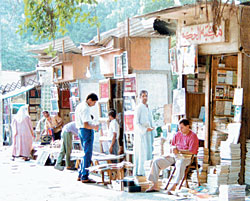If you are looking for a particular book in the Egyptian capital, head for the Azbakia Wall. But it is not just a place where books are bought and sold. Over the past 70 years or so, it has become a focal point for those in pursuit of culture and knowledge. The Azbakia Wall is a source of education and information where many Egyptians have drawn inspiration about culture and literature. And back to the wall their libraries and collections of books often go on their deaths. Thus the wall has been a witness to most major intellectual and cultural movements in Egypt and the Arab world.
Here in one of Cairo’s oldest areas, the Azbakia district is home to much of the capital’s artistic activity; there are cafes and clubs designed for pleasure-lovers and seekers as well as palaces belonging to the days of kings.
Napoleon Bonaparte built the first large theater there in Cairo to entertain his soldiers; when Muhammad Ali Basha took over, he ordered in 1872 a public park to be known officially as Azbakia Garden. As a result, the district won more fame and importance especially with the opening of the first opera house in Egypt and the hosting of festivities celebrating the opening of the Suez Canal. In the district the first national theater was built.
And yet the Azbakia Wall as an area for book selling bears a significance and importance that will endure for a long time. Those who sold books in the 18th century used to sell them by going from one place to another and when they grew tired, they would rest leaning against the wall. With the passage of time, the booksellers began putting their books on the iron fence of the garden instead of carrying them from place to place. And regardless of the police pursuing them because their “business” was unlicensed and illegal, they did not stop nor change.
In fact they continued until after the July 1952 when licenses legitimizing them were issued. So the Azbakia Wall became a cultural landmark for the display of world cultures, sciences and other literary movements. It can be said that all Egyptian authors without exception have visited the wall. And all of them without exception as well see their books being sold there. Among the wall’s most famous customers according to one of the sellers was the literary figure Yahya Haqi and the poet Amal Dunqal who used to borrow books rather than buy them. This is in addition to most current journalists, novelists and authors such as Yousef Al-Qaeed, Kamel Zuhairi, Jamal Al-Ghaitani. Among the actors sometimes seen there are Salah Al-Sadani, Nour Al-Sharif — not to mention a number of researchers and foreigners as well.
The libraries of prominent Egyptian authors and other educated people of culture have a special place along the Azkabia Wall. People may not be aware that the first Egyptian president, Muhammad Naguib, was an avid reader with a personal library containing over five thousand books on a variety of subjects. One of his sons sold the books to an Azkabia bookseller at the end of the 1980’s. The library of Abbas Mahmoud Al-Aqad, a prominent literary figure, is said to be one of the most famous personal libraries ever sold at the wall. His family gave eighteen thousand of his books to the Egyptian Book House while some five hundred were sold to booksellers at the wall.
Salama Musa, an intellectual and philosopher, has more than 1000 books at the Azbakia Wall. Personal libraries are among the most important resource for books on the Azbakia Wall with books being provided by the families of deceased prominent figures in the world of literature, culture, or even Al-Azhar — the principal religious institution in Egypt. There are those among the sellers who buy complete personal libraries in order to later sell the books separately based on rarity and value. Schoolbooks, magazines and newspapers are also found and bought at the wall. Old newspapers, especially those issued from days of significant historical events in Egypt or another part of the Arab world are also found at the Azbakia Wall. For example a copy of the Egyptian newspaper Al-Ihram dated 7 October 1973 carries the breaking news of the ‘October War.’ Another example is the newspaper issue detailing the nationalization of the Suez Canal as well as the one from the days of the Egyptian revolution ending the monarchy. There is also the newspaper with the story of the 1951 Cairo fire and the issue with the story of the union between Egypt and Syria in 1958. Special storage methods are used for newspapers because of their vulnerability to time. Among the most famous and popular treasures found and sold at the Azbakia Wall is the complete “Al-Jabarti History,” the entire “Thousand and One Nights” as well as a first edition of “Ibn Rumi.” Other books regarding the establishment of Muhammad Ali Basha’s state or the founding of modern Egypt are also there along the wall. The price of some books may rise to 4000 Egyptian pounds according to value and rarity.
The Azbakia Wall is not only a major point for book lovers and specialists where history and classics are concerned.
The wall is also in tune with the contemporary world as it includes compact CD’s, computerized magazines and a variety of technical reviews including information about the Internet. The present is different from the past and today’s customer is attracted by technology and what is modern.


